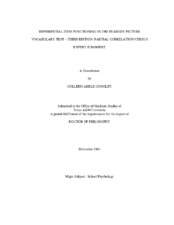| dc.description.abstract | This study had three purposes: (1) to identify differential item functioning (DIF) on the PPVT-III (Forms A & B) using a partial correlation method, (2) to find a consistent pattern in items identified as underestimating ability in each ethnic minority group, and (3) to compare findings from an expert judgment method and a partial correlation method. Hispanic, African American, and white subjects for the study were provided by American Guidance Service (AGS) from the standardization sample of the PPVT-III; English language learners (ELL) of Mexican descent were recruited from school districts in Central and South Texas. Content raters were all self-selected volunteers, each had advanced degrees, a career in education, and no special expertise of ELL or ethnic minorities. Two groups of teachers participated as judges for this study. The "expert" group was selected because of their special knowledge of ELL students of Mexican descent. The control group was all regular education teachers with limited exposure to ELL. Using the partial correlation method, DIF was detected within each group comparison. In all cases except with the ELL on form A of the PPVT-III, there were no significant differences in numbers of items found to have significant positive correlations versus significant negative correlations. On form A, the ELL group comparison indicated more items with negative correlation than positive correlation [χ2 (1) = 5.538; p=.019]. Among the items flagged as underestimating ability of the ELL group, no consistent trend could be detected. Also, it was found that none of the expert judges could adequately predict those items that would underestimate ability for the ELL group, despite expertise. Discussion includes possible consequences of item placement and recommendations regarding further research and use of the PPVT-III. | en |


